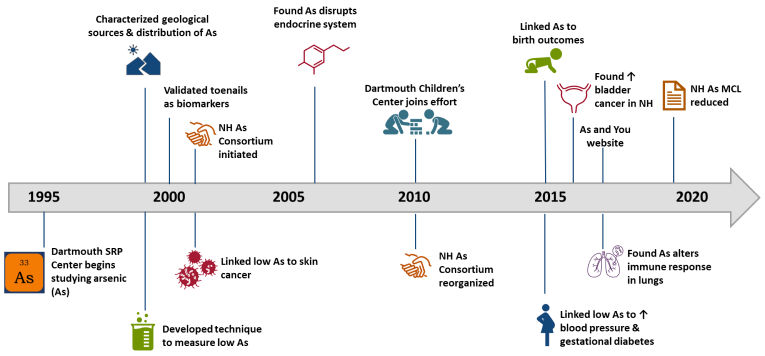How do I check my sample results?
How do I know what my results mean?
The Be Well Informed Guide from NHDES is designed to help you understand your water test results and, if your well water has commonly found pollutants in it, provide information about health concerns and water treatment choices.
When you enter your analytes, make sure you use the correct units. All units on All About Arsenic are in ug/L (micrograms/liter). Use a simple online conversion to switch between units (try Googling ug/L to mg/L).
Where should I go for well water advice?
Maine: 866-292-3474 or check out the ME well testing brochure.
New Hampshire: 603-271-2513 or check out the NH well testing brochure.
What are the Maximum Contaminate Levels (MCLs) for each analyte?
The numbers below are standards set by the EPA for the maximum contaminant amount allowed in drinking water. These are set to protect public health. There are a few exceptions to the Maximum Contaminant Levels.
| Contaminant | Symbol | EPA Maximum Contaminant Level |
| Beryllium | Be | 4 ug/L |
| Chromium | Cr | 100 ug/L |
| Manganese | Mn | 50 ug/L** |
| Iron | Fe | 300 ug/L** |
| Nickel | Ni | N/A |
| Copper | Cu | 1300 ug/L* |
| Arsenic | As | 10 ug/L |
| Selenium | Se | 50 ug/L |
| Cadmium | Cd | 5 ug/L |
| Antimony | Sb | 6 ug/L |
| Barium | Ba | 2000 ug/L |
| Thallium | Tl | 2 ug/L |
| Lead | Pb | 15 ug/L |
| Uranium | U | 30 ug/L |
| Phosphorus | P | N/A |
| Calcium | Ca | N/A |
| Sulfur | S | N/A |
| Magnesium | Mg | N/A |
| Molybdenum | Mo | N/A |
- *Lead and Copper are regulated under an action level because they enter drinking water primarily through plumbing materials. Treatment at the tap is recommended.
- **Iron and Manganese have “secondary standards” and are not usually health threatening. The EPA sets these standards because iron and manganese above these standards may cause your water to be discolored, taste funny, or have an odor.
- Nickel does not have a Maximum Contaminant Level.
- Phosphorus, Calcium, Sulfur, and Magnesium are all secondary standard with no limit, but that might be treated due to causing odor, staining, etc.
- Molybdenum does not have a formal standard.
What is the EPA limit for the amount of arsenic allowable in public drinking water?
The EPA limit for arsenic in public drinking water is 10 parts per billion(ppb), which is the same as 10 ug/L. This standard was adopted in 2001, replacing the old standard of 50 ug/L. Public water systems were required to meet the new standard by 2006.
Why does New Hampshire have a different Maximum Contaminant Level for arsenic?
On July 12, 2019, the New Hampshire governor signed a bill into law lowering the state’s drinking water limit for arsenic from the federal Maximum Contaminant Level of 10 ug/L to 5 ug/L. New Hampshire is the second state after New Jersey to lower their arsenic standard.
Research at the Dartmouth College Superfund Research Program Center informed this decision – read more about it here.

Is drinking water containing less than 10 ug/L of arsenic safe to drink?
The EPA’s goal is zero arsenic in drinking water. There isn’t really a”safe” level of arsenic because even low levels of arsenic may increase your risk of diseases like cancer, heart disease, and diabetes later in life.
Is it important to get your well tested for arsenic and other contaminants?
Yes. Bacteria, nitrates, arsenic, radon, uranium, lead, and copper are all important to test for. Watch this short video about concerns contaminants in drinking water can cause.
What should I do if I get a high test result?
If anything is above the recommended federal guidelines, a confirmation sample should be collected before making any decisions regarding water treatment. There are a number of certified water quality testing labs you can use (Maine labs and New Hampshire labs). It is a good idea to switch to drinking bottled water or buy a water pitcher filter until you confirm the first test, and then install a remediation system if necessary. The ZeroWater pitcher is a cost-effective short-term solution to filtering your drinking water.
Why do I have to retest my drinking water for arsenic every 3-5 years?
Water quality can change over time due to natural and human-induced causes, so it’s important to monitor your well water.
What are some of the health effects of well water contaminants?
The Agency for Toxic Substances and Disease Registry has lots of information on the health effects of exposure to toxic substances. Simply search for the toxin (e.g. arsenic or uranium) to find out more information.
Why are there so many units associate with drinking water limits?
The following units are equal: 10 ppb = 0.01 ppm = 0.01 mg/l = 10 ug/l
More Arsenic Information:
Other Contaminant Information:
- Uranium
- Manganese
- Iron and Manganese
- Lead and Copper
- Radon
- Beryllium
- Radionucleotides (uranium, radium, and radon)